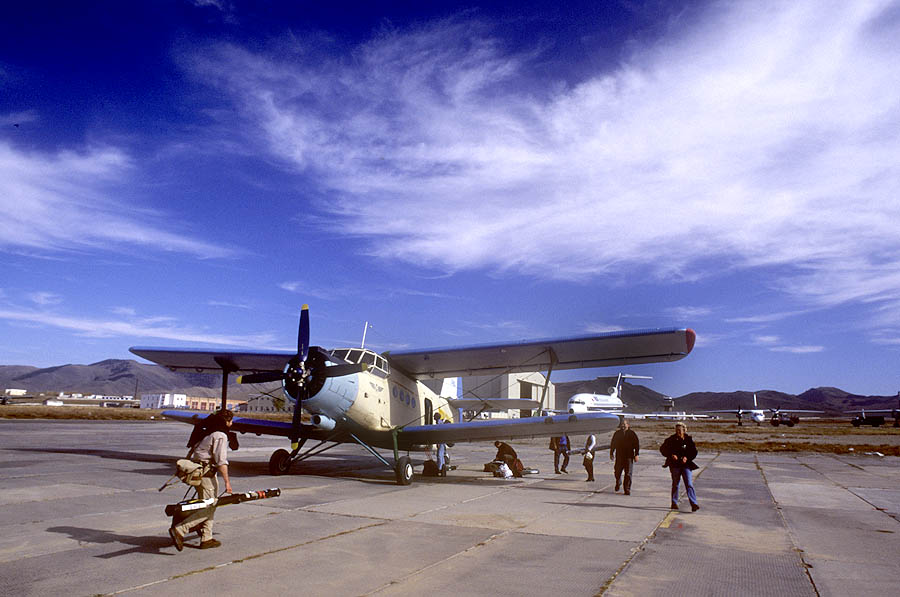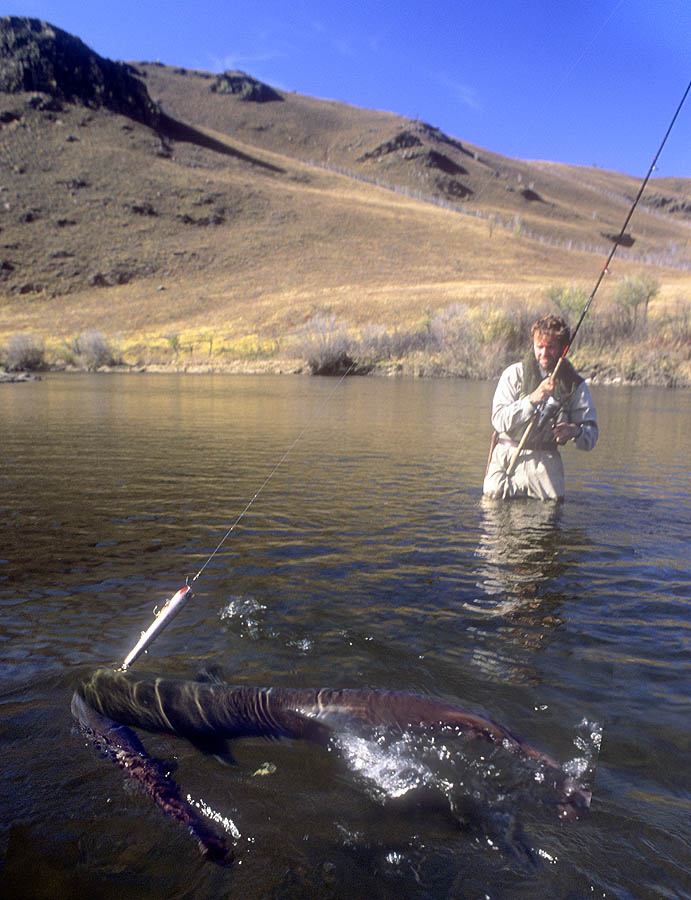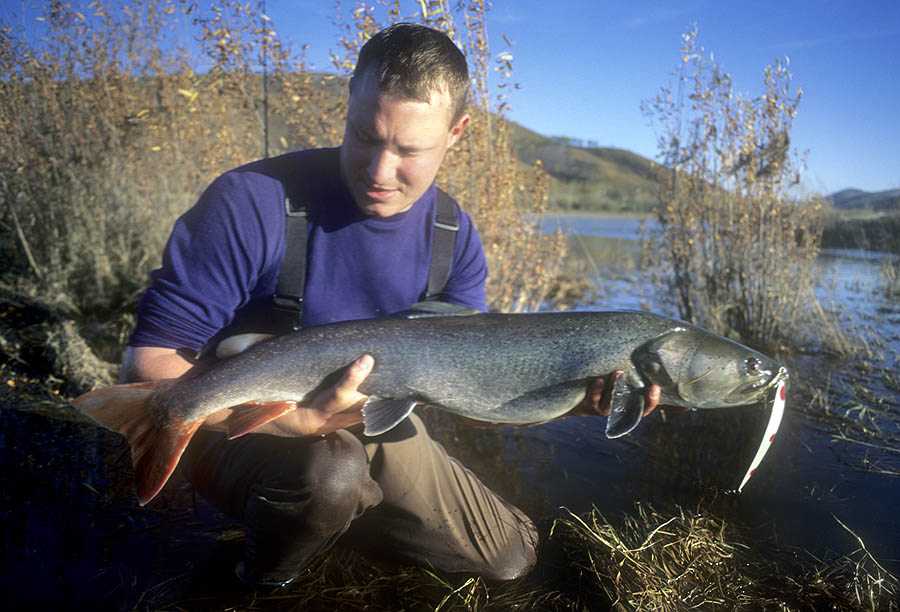 (1998) Genghis Khan ruled most of Asia and part of Europe in the 13th century. His name spread fear and horror wherever he appeared, and it was certainly not without reason. Few dared to challenge with him, and those who did anyway were brutally exterminated.
(1998) Genghis Khan ruled most of Asia and part of Europe in the 13th century. His name spread fear and horror wherever he appeared, and it was certainly not without reason. Few dared to challenge with him, and those who did anyway were brutally exterminated.
In the rivers of Mongolia, there is a salmon species that could actually rightly be called the Genghis Khan fish. It fears nothing, not even large pike, catfish or sturgeon.
In the fall of ’98, I went with John Bailey to Mongolia in search of this very special fish. The Onon River was the target - close to the Siberian border. The Onon River, part of the Amur River, is one of the richest fishing rivers in the world, with over 100 different species.
The taimen (Hucho taimen) is closely related to the more well-known Danube salmon (Hucho hucho) from Europe. Both of these species live primarily in rivers.
After quite a few hours of flying over the Asian continent, and another 2 hours of flying in Mongolia in a somewhat scary looking World War II double-decker aircraft (Antonov 2, AN-2), we reached Dadal, and from there it was a 3 hour jeep ride through rugged terrain. What really made the big difference from my home traffic was when we crossed the Balj river on a wired and rudder-driven raft, with 2 jeeps.
I can assure you that there were happy days fishing for the taimen. The Onon River itself was at high tide and turbulent due to the strong storms, so we put our efforts into the tributaries, which had clear water and plenty of fish. However, this meant that we had to hike or drive between 10 and 40 km almost every day.
 We caught the taimen on almost every bait imaginable, everything from large spinners, big spoons and jigs to baitfish, homemade hard baits and mega plugs of about 30 cm. At first glance, I would probably think that such large wobblers should only be used for pike (or sharks), but after 2 weeks of acquaintance with the taimen, I have no doubt anymore - they take everything that moves, even their own species and pike - so why not big plugs?
We caught the taimen on almost every bait imaginable, everything from large spinners, big spoons and jigs to baitfish, homemade hard baits and mega plugs of about 30 cm. At first glance, I would probably think that such large wobblers should only be used for pike (or sharks), but after 2 weeks of acquaintance with the taimen, I have no doubt anymore - they take everything that moves, even their own species and pike - so why not big plugs?
John had an excellent fight with a 6-7 kg taimen, which was snatched up by one of its own species of 20 kg. John struggled for another quarter of an hour with both fish until the big predator had had enough of the game, and let go of the smaller taimen. The smaller taimen escaped with its life, but it was marked for life by a huge bite mark on the back and abdomen.
We noticed quite a few taimen and pike with bite marks, also the largest we caught, which weighed 12-15 kg. During the fight with my biggest taimen, we experienced something that I think few people have seen. I had a taimen of about 9 kg on a Super Shad Rapala close below the brink at half a meter of clear water. It was getting tired and ready for landing when one of its slightly larger colleagues came rushing from the depths with sinister plans. At first I thought it was going to throw itself over my hooked fish, but it turned out to be the Rapala plug it had its eyes on. For a good 5 minutes it roamed around and tried to snatch the plug out of the mouth of my taimen.
I was considering how to get the wobbler from one fish to the other, as it was quite a few kilos bigger, but I never really came up with anything useful before the fish themselves solved the problem. Well, in part, because suddenly both fish were hooked on the plug. However, it lasted only a few seconds, and then the big taimen left the show. I got my 9 kg taimen, but what an experience that came with it.
Besides the taimen, we caught many Amur pike, lenok trout and Onon trout. Lenok trout (Brachymystax lenok) is beautifully dotted and has a destinct overbite. Onon trout (Brachymystax savinovi) is also beautifully dotted, but has a more normally directed mouth. Like lenok, it is an excellent fighter and it pleased our palates quite often when we were on the long hikes and decided to quench our hunger with a fire-fried fish.
We had quite a few by-catches in the form of Amur asp (Pseudaspius leptocephalus), Mongolian grayling (Thymallus brevirostris) and Baikal houting (Coregonus migratorius). The fish were largely similar to the European related species, but they were found in many small variations. For example, in Mongolia there are 6 types of grayling, 4 types of houting, 2 types of chub, etc...
 The fishing was unique and so were the fish, and to that came the completely different type of nature, huge expanses of grassland (taiga desert) and in the background forested mountain ridges.
The fishing was unique and so were the fish, and to that came the completely different type of nature, huge expanses of grassland (taiga desert) and in the background forested mountain ridges.
It must be said that nature and climate are somewhat harsh in Mongolia. For example, the temperature fluctuated over 30 degrees Celsius, from -10 degrees at night to +20 degrees during the day. And if there was just the slightest cloud cover and a little wind, then the daytime temperature fell all the way down to zero.
One of the most beautiful sunny days we experienced was transformed in 5 hours into gray weather and snow, so the next morning everything was covered by a 20 cm layer of snow. The sun was shining again and the snow was gone in a day. It was thus wisest to bring clothes for any kind of situation.
Saturated with impressions and experiences, it was time to go home. Our last night by the river was spent in festive company with our Mongolian friends. We probably drank more vodka than was good for us. Anyway, the condition was a bit rusty when we boarded the old double-decker plane the next day. The flight in such a machine is very active, you can really feel that you are flying, and after a couple of hours of flying, I badly wished we would land soon. My wish came through shortly after, but definitely not in a way I could have imagined. The plane's engine started coughing, throwing oil past the window where I was sitting, and a few seconds later the plane's only propeller stopped turning. Then all of a sudden it was very quiet in the plane, too quiet. You could only hear the wind rushing past, outside. And then it went downhill quickly. The pilot crash-dived the plane down towards the desert and landed miraculously enough without anyone getting hurt by the immensely hard landing. The plane’s landing gear was bent under the fuselage, but fortunately we were all ok.
We spent a cosy evening in Ulaan Baatar, which is the capital of Mongolia, where calmed our nerves with a little more vodka and good food.
All in all, one can only say that it was an experience of a lifetime, maybe a bit too exciting on the plane, but at least a lot of unforgettable memories.
